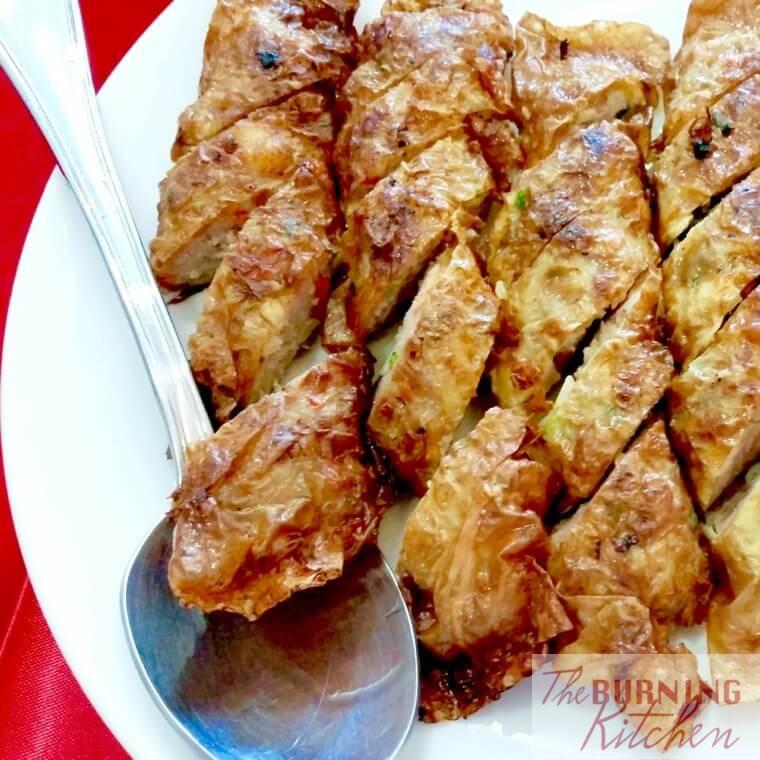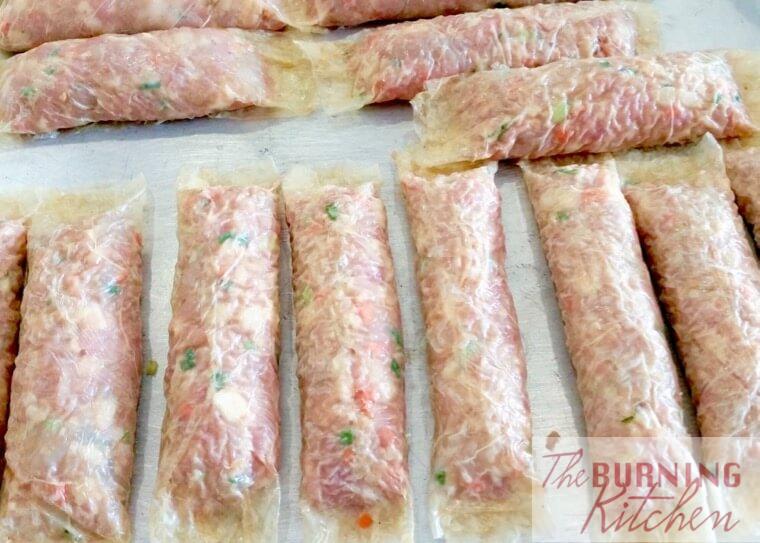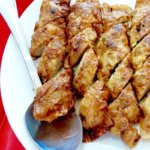
STORY BEHIND THE RECIPE
My eldest cousin makes what I think is the best Ngoh Hiang in the world. Growing up, we only got to eat it when there were weddings or birthday parties. So whenever there was, all of my cousins would anticipate the long awaited Ngoh Hiang that my Da Biao Jie would make!
GRAB OUR HERITAGE HAWKER DELIGHTS COOKBOOK + EBOOK BUNDLED DEAL FOR JUST $44.85 (U.P. $54.80)
In those days, there was no such luxury of electrical appliances. My eldest cousin would painstaking cut kilos and kilos of meat into very fine strips, which would take her hours to prepare – it is not easy because the cut of meat used, 五花肉 (Wu Hua Rou), is more fatty, so the meat is slippery to handle and tends to wobble.
WHAT I LOVE ABOUT THIS DISH
- It’s a family favourite for Chinese New Year, especially for me as it brings back childhood memories of family!
- The combination of fatty pork meat and prawn meat makes a really robust and umame flavour!
HOW TO MAKE NGOR HIANG (LOR BAK) ?

Mince the meat with a chopper but make sure not to over mince, otherwise it will be too powdery
Deshell and devein prawns and cut each prawn into 2 or 3 pieces.
Wash chestnuts with a brush to remove mud, and remove skin with a peeler and cut into small cubes
Peel the carrot and cut into small cubes. Wash the spring onions and cut into small pieces. Peel the shallots and cut into slices.
Put the cream crackers into a plastic bag and coarsely crush it
Crack the eggs and beat it, setting aside 1/4 of the mixture.
In a large mixing bowl, add all the ingredients and seasonings (besides the bean curd skin and 1/4 of the egg mixture) and mix well until it becomes sticky.

Use a clean, damp cloth to gently wipe the bean curd skin on both sides to get rid of the salt coating.
Cut the bean sheet into 16 equal squares.

Use a spoon and scoop about 2-3 TBsp of the meat mixture onto the bean curd square, leaving about 1cm perimeter along the skin

Dip your index finger into the egg mixture and glaze the perimeter of the beancurd square with it, then roll it up. Repeat for the other squares.
Place the rolls on an oiled tray, making sure that there is a gap between each roll.

Put water in a wok and bring it to a boil
Place the tray onto the rack to steam for about 15 mins

After steaming, let it cool completely before removing the rolls from the tray. Otherwise, the rolls will break.
In a wok, heat 2 bowls of oil over medium fire.
Slowly put one roll in first to test the temperature. Fry until golden brown, then repeat with the other rolls.

Slice each roll diagonally into bite sized pieces. Serve with sweet sauce and chilli sauce.

MARKETING TIPS
- The meat must not be too lean. It must have some fat layers in between, or it will be too dry and dehydrated after cooking. Wu Hua Rou is a good cut of meat to use.
- For prawns, it is best to buy ‘Swa Loh’ ( Swa Low Hei in Teochew) from the market. These prawns are ugly looking with a very rough and sandy shell but they are very sweet and crunchy. Their heads once exposed to the air will turn black in color – its normal, not spoilt!
- Buy the right sweet sauce. There are many kinds in the market, so be careful to buy the kind of sweet sauce for Ngoh Hiang, which is this Tai Hua brand of sweet sauce.

PREP TIPS
- Be careful not to overmince the meat, or the roll will turn out mushy and there won’t be much substance in the roll.
- Do not crush or smash the water chestnut. Just cut it into small cube to retain its juices and crunchiness.
- Do not cut the prawns too small. You can cut into 2 or 3 pieces for medium size prawns.
- Wipe the bean curd sheet with a damp cloth or it will be extremely salty. Bean curd skin is usually coated with salt to extend its shelf life.
COOKING TIPS
- Do not remove the steaming hot rolls immediately from the tray or it will break. Wait till it’s cooled completely.
- Deep fry the rolls without steaming as an alternative. But you’ll need to control the temperature of the oil more carefully. If the oil is too hot, the skin will get burnt but the filling will still not be cooked through. If it’s not hot enough, it will absorb too much oil making it very greasy.
- Turn the heat higher for the first few seconds when the Ngor Hiang is turning slightly golden to purge out the excess oil from it. Again, watch for the temperature.
- Place the ngor hiang on the kitchen towel after frying to absorb the excess oil.
HOW TO FOLD BEANCURD SKIN
- The easiest way is to fold the bean sheets into half, and then half again to get 4 equal sized strips. Then cut along the fold. Next, fold each strip into half and then half again, and then cut along the fold. That should give you about 16 square pieces of equal size.
- Alternatively, make a shorter roll by cutting the beancurd sheet to the right width first maybe 10-12cm wide and leave the length uncut. Place the filling on the skin nearer to you, lift up the skin and roll it once over and cut off form the length. This method does not require cutting after frying.
HOW TO WRAP NGOR HIANG
- Leave about 1 cm perimeter along the edges of the sheet when spreading the fillings so that you can seal it with the egg wash or the starch mixture from the filling.
- Make sure both ends and the edge of the skin are properly and firmly sealed. Or you can use the back of the spoon which has the starch mixture from the filling to glaze the perimeters of the roll to seal it
- Make sure you push out any air when folding. Any trapped air bubbles inside the roll will expand during steaming, bursting the skin.
- use your finger to press the fillings firmly against the bean curd sheet
- press on both ends of the sheet with your index fingers to push out the air as well.
- On the other hand, don’t roll it so tightly that the filling becomes too compacted and hard.
- Do not wrap the filling with the skin more than 2 times, as you will be eating too much skin and it may be too salty.
STORING TIPS
- Any extra filling can be deep fried as meat patties by coating it with cornflour before deep frying it.
- The steamed Ngor Hiang can be freezed for later use. Place the roll into a tupperware without the rolls touch each other, especially the end parts. Place a clean plastic sheet over the first layer before stacking the next layer on top of it.
DIETARY INFORMATION
- Fish-Free: No modifications required
- Gluten-Free: Use gluten free sauces
- Nut-Free: No modifications needed.
- Shellfish-Free: No modifications required
TRIED THIS RECIPE?
Please rate our recipe or leave us a comment! You can even upload a snap of your creation!
Don’t forget to subscribe to our Youtube channel for more yummy videos! Do also join us at TBK Home Cooks Facebook Group where you can post photos of your food, ask questions, share recipes and clean cooking tips from others in the group!
Ngor Hiang (Lor Bak)
Ingredients
- 1 kg minced pork wu hua rou
- 600 gm prawns
- 12 shallots
- 1 carrot
- 20 water chestnuts
- 10 cream crackers unsalted, optional
- 2.5 tsp five spices powder
- 1.5 tsp fine salt
- 2 tsp light soya sauce
- 1 Tbsp cornflour
- 2 egg
- 1 Tbsp sesame oil
- 1 Tbsp cooking oil
- 0.5 tsp pepper
- 1 bean curd sheet
- 2 stalks spring onion
Instructions
PREPARATION METHOD
- Mince the meat with a chopper but make sure not to over mince, otherwise it will be too powdery
- Deshell and devein prawns and cut each prawn into 2 or 3 pieces.
- Wash chestnuts with a brush to remove mud, and remove skin with a peeler and cut into small cubes
- Peel the carrot and cut into small cubes. Wash the spring onions and cut into small pieces. Peel the shallots and cut into slices.
- Put the cream crackers into a plastic bag and coarsely crush it
- Crack the eggs and beat it, setting aside 1/4 of the mixture.
- In a large mixing bowl, add all the ingredients and seasonings (besides the bean curd skin and 1/4 of the egg mixture) and mix well until it becomes sticky.
- Use a clean, damp cloth to gently wipe the bean curd skin on both sides to get rid of the salt coating.
- Cut the bean sheet into 16 equal squares.
- Use a spoon and scoop about 2-3 TBsp of the meat mixture onto the bean curd square, leaving about 1cm perimeter along the skin
- Dip your index finger into the egg mixture and glaze the perimeter of the beancurd square with it, then roll it up. Repeat for the other squares.
- Place the rolls on an oiled tray, making sure that there is a gap between each roll.
COOKING METHOD
- Put water in a wok and bring it to a boil
- Place the tray onto the rack to steam for about 15 mins.
- After steaming, let it cool completely before removing the rolls from the tray. Otherwise, the rolls will break.
- In a wok, heat 2 bowls of oil over medium fire.
- Slowly put one roll in first to test the temperature. Fry until golden brown, then repeat with the other rolls.
- Slice each roll diagonally into bite sized pieces. Serve with sweet sauce and chilli sauce.
Notes
MARKETING TIPS
- The meat must not be too lean. It must have some fat layers in between, or it will be too dry and dehydrated after cooking. Wu Hua Rou is a good cut of meat to use.
- For prawns, it is best to buy 'Swa Loh' ( Swa Low Hei in Teochew) from the market. These prawns are ugly looking with a very rough and sandy shell but they are very sweet and crunchy. Their heads once exposed to the air will turn black in color - its normal, not spoilt!
- Buy the right sweet sauce. There are many kinds in the market, so be careful to buy the kind of sweet sauce for Ngoh Hiang, which is the Tai Hua brand of sweet sauce.
PREP TIPS
- Be careful not to overmince the meat, or the roll will turn out mushy and there won't be much substance in the roll.
- Do not crush or smash the water chestnut. Just cut it into small cube to retain its juices and crunchiness.
- Do not cut the prawns too small. You can cut into 2 or 3 pieces for medium size prawns.
- Wipe the bean curd sheet with a damp cloth or it will be extremely salty. Bean curd skin is usually coated with salt to extend its shelf life.
COOKING TIPS
- Do not remove the steaming hot rolls immediately from the tray or it will break. Wait till it's cooled completely.
- Deep fry the rolls without steaming as an alternative. But you'll need to control the temperature of the oil more carefully. If the oil is too hot, the skin will get burnt but the filling will still not be cooked through. If it's not hot enough, it will absorb too much oil making it very greasy.
- Turn the heat higher for the first few seconds when the Ngor Hiang is turning slightly golden to purge out the excess oil from it. Again, watch for the temperature.
- Place the ngor hiang on the kitchen towel after frying to absorb the excess oil.
HOW TO FOLD BEANCURD SKIN
- The easiest way is to fold the bean sheets into half, and then half again to get 4 equal sized strips. Then cut along the fold. Next, fold each strip into half and then half again, and then cut along the fold. That should give you about 16 square pieces of equal size.
- Alternatively, make a shorter roll by cutting the beancurd sheet to the right width first maybe 10-12cm wide and leave the length uncut. Place the filling on the skin nearer to you, lift up the skin and roll it once over and cut off form the length. This method does not require cutting after frying.
HOW TO WRAP NGOR HIANG
- Leave about 1 cm perimeter along the edges of the sheet when spreading the fillings so that you can seal it with the egg wash or the starch mixture from the filling.
- Make sure both ends and the edge of the skin are properly and firmly sealed. Or you can use the back of the spoon which has the starch mixture from the filling to glaze the perimeters of the roll to seal it
- Make sure you push out any air when folding. Any trapped air bubbles inside the roll will expand during steaming, bursting the skin.
- use your finger to press the fillings firmly against the bean curd sheet
- press on both ends of the sheet with your index fingers to push out the air as well.
- On the other hand, don't roll it so tightly that the filling becomes too compacted and hard.
- Do not wrap the filling with the skin more than 2 times, as you will be eating too much skin and it may be too salty.
STORING TIPS
- Any extra filling can be deep fried as meat patties by coating it with cornflour before deep frying it.
- The steamed Ngor Hiang can be freezed for later use. Place the roll into a tupperware without the rolls touch each other, especially the end parts. Place a clean plastic sheet over the first layer before stacking the next layer on top of it.











This recipe looks yummy.
May I ask where in the recipe is the sweet soy used? Should it be sweet soy instead of the light soy sauce listed in the ingredients? Tks.